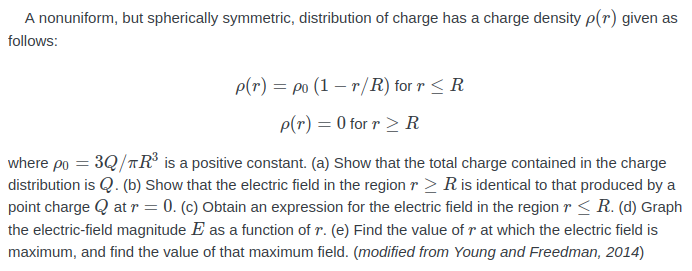A nonuniform, but spherically symmetric, distribution of charge has a charge density p(r) given as follows: p(r) = po (1 – r/R) for r < R p(r) = 0 for r > R where po = 3Q/TR° is a positive constant. (a) Show that the total charge contained in the charge distribution is Q. (b) Show that the electric field in the region r > Ris identical to that produced by a point charge Q at r = 0. (c) Obtain an expression for the electric field in the region r < R. (d) Graph
A nonuniform, but spherically symmetric, distribution of charge has a charge density p(r) given as follows: p(r) = po (1 – r/R) for r < R p(r) = 0 for r > R where po = 3Q/TR° is a positive constant. (a) Show that the total charge contained in the charge distribution is Q. (b) Show that the electric field in the region r > Ris identical to that produced by a point charge Q at r = 0. (c) Obtain an expression for the electric field in the region r < R. (d) Graph
Related questions
Question

Transcribed Image Text:A nonuniform, but spherically symmetric, distribution of charge has a charge density p(r) given as
follows:
p(r) = po (1 – r/R) for r < R
p(r) = 0 for r > R
where po = 3Q/TR° is a positive constant. (a) Show that the total charge contained in the charge
distribution is Q. (b) Show that the electric field in the region r > Ris identical to that produced by a
point charge Q at r = 0. (c) Obtain an expression for the electric field in the region r < R. (d) Graph
the electric-field magnitude E as a function of r. (e) Find the value of r at which the electric field is
maximum, and find the value of that maximum field. (modified from Young and Freedman, 2014)
Expert Solution
This question has been solved!
Explore an expertly crafted, step-by-step solution for a thorough understanding of key concepts.
This is a popular solution!
Trending now
This is a popular solution!
Step by step
Solved in 3 steps
